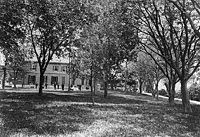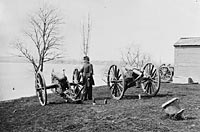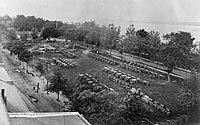The Armory was one of the places to which the President frequently walked from the White House for diversion as well as official business. Early in the war, President Lincoln took a walk and discovered the open doors of the Armory unguarded. As the President later reported the incident to Carl Schurz: “One afternoon after he had issued his call for troops, he sat alone in [his office], and a feeling came over him as if he were utterly deserted and helpless. He thought any moderately strong body of secessionist troops, if there were any in the neighborhood, might come over the ‘long bridge’ across the Potomac River, and just take him and the members of the Cabinet – the whole lot of them. Then he suddenly heard a sound like the boom of a cannon. ‘There they are!’ he said to himself. He expected every moment somebody would rush in with the report of an attack. The White House attendants, whom he interrogated, had heard nothing. But nobody came, and all remained still. Then he thought he would look after the thing himself. So he walked out, and walked, and walked, until he got to the Arsenal. There he found the doors all open and not a soul to guard them. Anybody might have gone in and helped himself to the arms. There was a perfect solitude and stillness all around. Then he walked back to the White House without noticing the slightest sign of disturbance. He met a few persons on the way, some of whom he asked whether they had not heard something like the boom of a cannon. Nobody had heard anything, and so he supposed it must have been a freak of his imagination.”1
On August 19, 1863, John Hay recorded in his diary: “This evening and yesterday evening an hour was spent by the President in shooting with Spencer’s new repeating rifle. A wonderful gun, loading with absolutely contemptible simplicity and ease with seven balls & firing the whole readily & deliberately in less than half a minute. The President made some pretty good shots. Spencer, the inventor, a quiet little Yankee who sold himself in relentless slavery to his idea for six weary years before it was perfect, did some splendid shooting. My shooting was the most lamentably bad. My eyes are gradually failing. I can scarcely see the target two inches wide at thirty yards.”2
According to The Stranger’s Guide-book to Washington City, the Armory “ was designed as a depository of arms for the District of Columbia militia, and of national trophies, relics, flags, &c.,” wrote T. Loftin Snell. “It is built of brick, painted white, and is three stories high ; 103 feet long and 57 feet wide. It is a fine piece of architecture. Iron columns support the floors of the second and third stories. It is situated on the “Island,” between Sixth and Seventh streets; on the “Mall” or public ground between the Capitol and Smithsonian Institute.”3
The Arsenal was located along the Potomac in Southwest Washignton. General George Ramsay commanded the Washington Arsenal at the beginning of the Civil War – until being named to chief of ordnance in September 1863. He shared President Lincoln’s interest in more efficient and more effective weapons. As The Stranger’s Guide-book to Washington City reported in 1864: “At some distance south of the Capitol, and at the junction of the Eastern Branch with the Potomac, on what is known as Greenleaf ‘s Point, is situated the Washington Arsenal. It is surrounded on three sides by water, and presents a fine appearance. Here are prepared all kinds of ordnance, by the best and latest improvements in machinery adapted to the purpose. The storehouse and buildings are spacious, and are filled with warlike instruments of all kinds. Besides, there are collected here a number of famous batteries which have done good service in wars in which the United States have been engaged.”4
Footnotes
- Carl Schurz, The Reminiscences of Carl Schurz, Volume II, pp. 227-228.
- Michael Burlingame and John R. Turner Ettlinger, editors, Inside Lincoln’s White House: The Complete Civil War Diary of John Hay, p. 75 (August 19, 1863).
- T. Loftin Snell, The Stranger’s Guide-book to Washington City, pp. 34.
- T. Loftin Snell, The Stranger’s Guide-book to Washington City, pp. 34.
Visit











